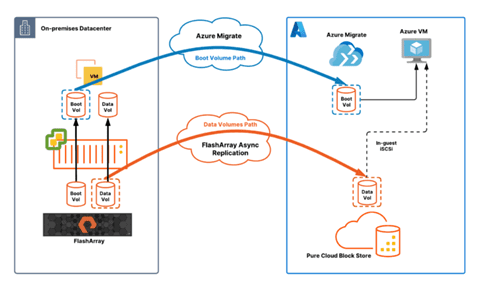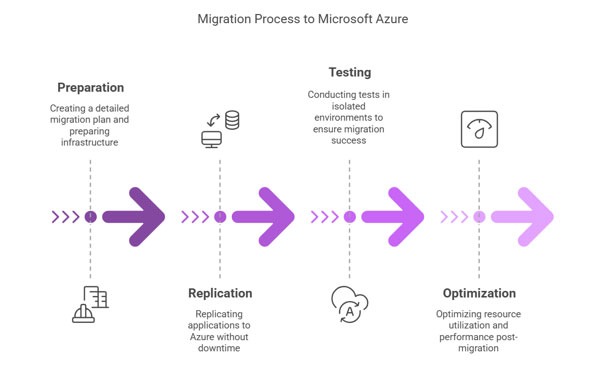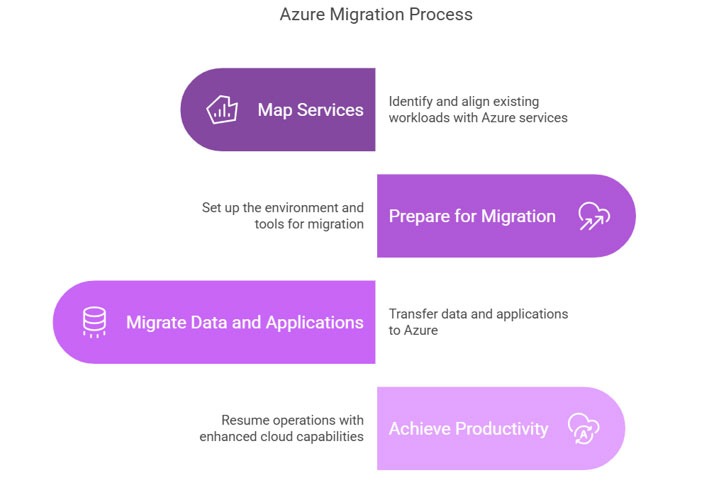- April 17, 2024
Moving from On-Premises to Azure: A Seamless Cloud Migration Journey
Is your business struggling to keep pace with digital transformation demands? Migrating from on-premises servers to the Azure cloud is a crucial step for businesses seeking to enhance agility and innovation.
Azure’s cloud and O365 services offer critical advantages for both SMBs and large enterprises, enabling a robust hybrid infrastructure essential for industry growth. Migrating to Azure is not just a technical upgrade, it’s a strategic decision that offers scalability, speed to market, and improved operational efficiency.
In this blog, we provide a detailed step-by-step guide for migrating from on-premises to Azure, examining the distinct services Microsoft Azure provides and the important factors to consider. Whether SMBs or a large corporation, learn how Azure’s managed cloud services can drive your digital transformation forward.
With the global cloud computing market expected to reach $1,076 billion by 2028, Microsoft Azure continues to be a key player, capturing a significant share of the market and driving technological advancements.
Understanding Microsoft Azure Migration Process

Well-known Microsoft Azure is defined as an integral cloud computing platform that distributes industry needs with advanced cloud solutions.
Microsoft Azure is an extensive cloud computing platform developed by Microsoft that allows businesses to build, test, deploy, and manage applications and services through its global network of Microsoft-managed data centers.
It offers a wide array of cloud services, including computing, analytics, storage, and networking, enabling users to select the services they need to develop and scale new applications or run existing applications in the public cloud.
Comprising over 200 global services including Saas, PaaS, and IaaS, Azure services are hosted across over 200 Microsoft-managed data centers around the world.
As one of the world’s leading cloud providers, Azure cloud migration process comprise of modernized technologies, a secure global network, and seamless scalability to leverage frictionless solutions in enterprises or businesses.
Azure data network centers provide enterprise-grade cloud infrastructure, with high availability, scalability, and technical capabilities required to host robust applications and move from on-premises to azure cloud migration. M365 business premium can be subscribed to as an add-on from Azure by the organizations or users for more advantages.
Key Offerings of Microsoft Azure services include:
Compute Resources: Microsoft Azure provides a range of computing options, including virtual machines, containers, and serverless computing, allowing you to scale resources up or down based on demand and ensuring cost efficiency by paying only for what you use.
Storage Solutions: Azure offers scalable cloud storage options for a wide range of data needs, supporting both structured and unstructured data. It includes storage for data objects, file systems, and databases, making it suitable for diverse storage requirements.
Networking Capabilities: With Azure Virtual Network , you can create private networks for secure communication. Additionally, Azure ExpressRoute offers private connections to Azure services, enhancing network performance and security.
AI and Machine Learning: Azure provides a comprehensive suite of AI and machine learning tools , enabling the development of intelligent applications. You can leverage pre-built AI services or create custom machine learning models to meet your specific needs.
Step-by-Step Process to migrate On-Premises Servers to Azure
The Migration from On-premises to Azure starts right after choosing the Cloud managed providers that accept your business needs with flexible and scalable features. To undergo seamless transition of infrastructure and efficient adoption of cloud environment, Microsoft Azure recommends a multi-step migration process that includes Assessment, Migrate, Optimize, and Secure and Manage.
This result-driven approach Provides a clear path across cloud adoption with suitable migration applications that efficiently optimizes ensuring cloud security and high performance. Here goes the step-by-step process to migrate on-premises servers to Microsoft Azure cloud services.
- Preparation
- Replication
- Testing
- Optimize
Step-1: Preparation – Create a Migration Plan
- Firstly, get along with the planning process and check for the crucial members of the team before the process starts. Prepare Azure cloud service infrastructure and make sure all your functionalities are ready to migrate the applications.
- The process includes verification of the permissions and creation of the Azure network on the cloud, along with other validations. Create a detailed plan for your migration evaluating the skillset of your organization.
- Prepare the target applications or Virtual Machines for on-premises to Azure cloud migration as it would involve reviewing the operation system requirements for the destined infrastructure.
- Evaluate the cost and expenditure of the migration from on-premises to Azure cloud by calculating the Total Cost of Ownership (TCO). This is a tool designed by Microsoft to calculate TCO based on your on-premises server infrastructure, databases, storage, and bandwidth.
- • Personalize the needs of your business with custom-made cloud strategies and Azure cloud assessment tools that help in mapping out current applications and assist in ultimate migration processes.
Step-2: Replication
- Application replication is the next process to perform after preparation to On-premises to Azure cloud migration. The applications are replicated to the desired locations without any external help of applications or workload framework changes.
- There can be several approaches involved for application and VM replications. The Real-Time image is a standardized one that most of the organizations follow as it allows them to migrate applications while in the running process without any downtime.
- Beyond that, several migration tools support Real-Time image by keeping the migration active for a long time and copying the initial workload to the target cloud location and then simultaneously performing an asynchronous replication.
- While the replication process is active ensure all the connections and dependencies are keenly followed and taken care of by the expert teams.
- Ensure database is accessible from the desired location for proper connectivity. These factors are mostly considered by several migration tools and support replication mitigating risks in the migration process of Azure.
Step-3: Testing
- To regulate risks and failures, testing is the primary step to follow to ensure the intended migration process. There are few migration tools that support on-premises to Azure migration processes with testing to ensure problem-free migration without impacting the other operational services.
- Some tools allow users to set up isolated environments to stimulate the production environments and enabling testing applications without impacting the existing workloads.
- Users test the applications in isolated environments and swift to the production environment if all is set and ready to go.
Step-4: Optimization
- After the whole Azure migration process , optimizing the resource utilization and performance is important to gain maximum returns. Optimization helps in saving costs and enhancing performance.
- Microsoft solutions for modern work offers Cost management and billing services to identify trends and raise alerts for possible inefficiencies and provide recommendations for VM instances.

Why should you choose On-Premises to Azure Cloud Migration?
On-premises to Azure migration benefits various business groups including small and medium. They are cost-effective, agile, and secure, making organizations realize significant savings in the infrastructure and its upkeep maintenance-related expenditure.
Azure Cloud infrastructure like Azure allows organizations to host their workloads within proximity of their users to deliver their services with optimized performance irrespective of regions.
- High-Availability: Microsoft Azure cloud services, a global cloud computing platform promotes services with high availability, mitigating the risk of downtime, and fraudulent or failing hardware that often coincides with single data centers
- Disaster Recovery: On-premises to Azure cloud migration process comes with the extreme benefit of disaster recovery where Azure disaster recovery system is designed to help businesses keep operating during challenging times. As one of the leading Disaster Recovery as a Service (DRaaS) it offers security more than on-premises data centers with cost-optimization and maintenance.
- Agility: On-premises to Azure migration involve tools that make the migration process rapid and flexible. It helps organizations achieve long-term value at a longer pace.
- Compliance: Microsoft Azure cloud platform offers more than 90 compliance certifications and 35+ industry-specific certifications spanning from healthcare to finance, government, and many other industries sticking to compliance regulations.
- Data Security: With security tools that are designed to analyze, help, and react to security threats, their products like Threat Intelligence, Advanced Threat Analytics, and Multi-Factor Authorization help in data security and protection around the clock. Security optimization assessment in Azure provides prescriptive practices to enhance security of workloads.
- Seamless Integration: For existing customers utilizing tools and products can be much more feasible to access. However, Azure is a less expensive route with quick and seamless integration into your existing system. Seamless integration is guaranteed with many unique perks which an organization can capitalize on.
Essential Microsoft Azure Migration Strategies for SMBs
These three Azure cloud migration strategies will help you understand what is best for your business.
- Retain: At some point, due to legal issues, you might think of suspending your cloud migration process, you can resume it later. The issue can be because you are not allowed to store data on a third-party platform, and you might confront high license costs too.
- Rehost: Transform your existing solution from on-premises to Azure cloud without any changes and implement cost-efficient methods.
- Re-Platform: Adjust according to your business. The core architecture remains the same and solutions are modified to match your business. It is merely like migrating a database from one cloud platform to another.
Why Choose HexaCorp for On-premises to Azure Cloud Migration services?
- HexaCorp is one of the leading IT service companies to provide end-to-end Azure managed services with all the migration, modernization and scalable features required to enhance your business growth.
- Our flexible and robust technology features like Proactive cloud monitoring & incident response, Backup & Disaster recovery, Infrastructure as code, Reporting, Security & Compliance, 24/7 Technical support, DevOps automation, VPN Firewall support, Updates & Patches, and cost-optimization fix your business needs according to the industry standards.
- We take enterprises towards digital destiny encouraging operational efficiency, increasing agility, at lowest costs and leveraging best cloud solutions by reducing complexities in the migration process.
- As one of the Microsoft partners, we assure reliable, scalable, and feasible on-premises to Azure cloud migrations with simplified and modernized methodologies.
How to quickly move the workloads to the cloud with Azure managed cloud services
- Discover: Identify your existing workloads and your infrastructure applications to get them ready for the Azure cloud migration and modernization process. You do not want to miss any applications later and it would lead to waste of time.
- Assess: Start evaluating your existing infrastructure to have a better understanding of the Azure migration strategy and solutions that fit your business well.
- Target: It is time to map your services in the Azure managed service platform. Ask questions to yourself related to mapping your existing workloads in Azure. Consult Azure cloud service provider for better assistance.
- Migrate: Now you are ready to migrate your existing data and applications after mapping the services in Azure and get back to your successful productivity after a splendid Azure migration process.

Conclusion
On-Premises to Azure Cloud Migrations are essential for businesses and organizations to enhance and modernize with several advantages that makes them stay competitive in the marketplace. Microsoft Azure makes the process even more flexible and sophisticated with a wide range of tools allowing businesses to adapt to the cloud infrastructure. Choose the right fit for your business and you are unstoppable!
For more information related to Azure cloud migration with HexaCorp, please feel free to contact us via email or visit our website www.hexacorp.com to talk to our Azure experts.
Happy Learning!!
FAQ:
Why should I move from on-premises to Azure?
Azure migration distinguishes itself with advantages such as scalability, security, and cost efficiency while leaving its users free from hardware maintenance. Advanced analytics, coupled with artificial intelligence integration and global reach, are included benefits it comes with.
What are the key steps in migrating from on-premises to Azure?
The process includes assessment, planning, choosing the appropriate migration strategy (whether rehost, refactor, rearchitect, or rebuild), performing the migration, and optimizing post-migration performance. Throughout, there must be consideration to governance and security configurations.
How long does it take to migrate from on-premises to Azure?
The time span varies according to the complicity, the volume of data, and the strategy for migration which generally ranges from a few weeks to several months. A well-planned phased execution of migration helps to avoid causing disruptions to normal operations while ensuring efficient delivery.
What are the common challenges in Azure migration?
The major ones include application compatibility, data transfer bottlenecks, security issues, and cost management. Precise and careful planning, coupled with automation tools and expert advice, all help mitigate these.
What is the cost of migrating to Azure?
The varied costs between those associated with size of the infrastructure, licenses, storage, and the overall approach to migration, make it difficult to quantify costs; however, by virtue of its pay-as-you-go solution, Azure guarantees cost optimization. Using cost estimation tools and reserved instances can further reduce expenses.




